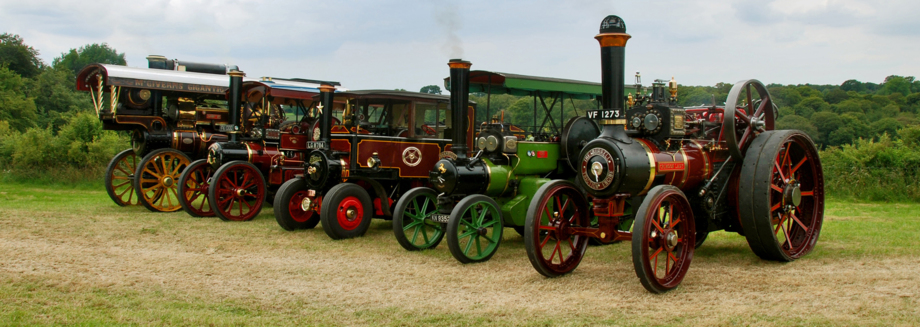Spot the difference and word serach games are found in the sub folders on the left of this page.
What is a Traction Engine?
A traction engine is a self-propelled steam engine. The name derives from the Latin name tractus, meaning 'drawn', since the prime function of any traction engine is to draw/move heavy loads or to provide power to other machinery via a belt or winch cable.
The traction engine, in the form recognisable today, was developed as an experiment in
1859 when Thomas Aveling modified a Clayton & Shuttleworth portable engine.
Before this time portable engines had to be hauled from job to job by horses. The alteration was made by fitting a long driving chain between the crankshaft and the rear axle. Although these first
engines employed a chain drive, it later became more typical for large gears to be used to transfer the drive from the crankshaft to the rear axle.
The first half of the 1860s was a period of great experimentation but by the end of the decade the standard form of the traction engine had evolved and changed very little over the next sixty years.
It also demonstrated that steam power had economic advantages over horse power for hauling heavy loads and over the years road engines also known as locos, became bigger, faster and
stronger.
However by the early 20th century the internal
combustion engine was invented – powered tractors and lorries were starting to show better efficiency
and could be purchased cheaply, run further and faster than steam. Throughout the 1920s and 1930s there were tighter restrictions on road steam haulage, with different
taxes and it was this that made steam engines less competitive against domestically produced petrol engines. The tax was devastating to the businesses of heavy hauliers and showmen and precipitated
the scrapping of many engines. The last new UK-built traction engines were constructed during the 1930s, although any continued in commercial use for many years while there remained experienced
enginemen available to drive them.
From the 1950s, the 'preservation movement' started to build up as enthusiasts realised that these lumbering beasts were in danger of dying out. Many of the remaining engines were snapped up by enthusiasts, and restored to working order. Traction engine rallies began, initially as races between engine owners and later developing into the significant tourist attraction that takes place in many locations around the UK each year. It has been estimated that over two thousand traction engines have been preserved.
The commercial use of traction engines over the years saw a variety of roles between the mid-nineteenth and mid-twentieth centuries. Each role required a machine with a different set of characteristics, and the traction engine evolved into a number of different types to suit the job.
Agricultural (general purpose) engine:
The most common form in the countryside. They were used for hauling and
as a stationary power source. Even when farmers did not own such a machine they would rely upon it from time to time. Many farms would use draught
horses throughout the year, but during the harvest,
threshing contractors would travel from farm to farm hauling the threshing
machine which would be set up in the field and powered
from the fly-wheel through a belt.
Ploughing engine:
The largest and
longest traction engines to be built. Very distinctive by a large diameter winding drum fitted under the belly of the boiler and sat in between the front and back wheels. These engines mostly working
in pairs, one on each side of the field, with a metal rope cable linked together by the implement (e.g. commonly the plough). The engines would pull the plough across the field using
the engines whistles to signal and communicate between the two drivers.
Steam tractor:
This name is more usually
applied to the smaller and faster models of traction engine, used for hauling small loads. They were popular in the timber trade in the UK, although variations were also
designed for showman's use.
Road locomotive (Locos):
Designed for heavy haulage It was common for two or even three to be
coupled together to allow heavier loads to be handled. The characteristic features of these engines are very large rear driving wheels, three-speed gearing (most traction engine types have only
two
gears), rear suspension, and belly tanks to provide a greater range between the stops needed to replenish water. A particularly distinctive form of road locomotive was the Showman's
engine. These were operated by travelling showmen both to tow fairground equipment and to power it once set up, either directly or by running a generator. These were
usually highly decorated and formed part of the spectacle of the fair. Some were fitted with a small crane that could be used when assembling the ride.
Steamroller:
Another distinct form of the steam traction engine, used for road
building and flattening ground. Typically designed with a front single roll, replacing the front wheels, and smooth rear
wheels.
Steam wagon:
A steam wagon was an early form of lorry to carry freight
and came in two basic forms: overtype and
undertype – the distinction being the position of the engine/cylinder block relative to the boiler.
The overtype had the engine/cylinder block mounted on top of the boiler, in a similar manner to a traction engine (e.g. Foden’s) and the under
type is typically used by Sentinel, where their engine was mounted under the chassis and in between the wheels.



